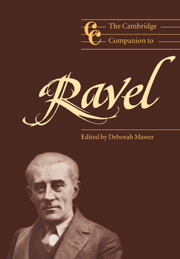Appendix: Early reception of Ravel's music (1899–1939)
Published online by Cambridge University Press: 28 September 2011
Summary
Ravel and the critics
roger nichols
Like most composers, Ravel had his staunch defenders and his virulent opponents as well as one or two critics (in many ways the most interesting for us) who tried to take each of his works on its merits.
Of his defenders, the eldest was Willy (Henri Gauthier-Villars, 1859–1931) who, despite his love ofWagner, had also been one of the few early champions of Debussy’s L’Après-midi. If he was caustic over the early overture Shéhérazade, this was no more than Ravel came to be himself, and his willingness to praise the ‘orchestre de rêve’ of Daphnis may have been due in part to his pleasure in seeing fulfilled his prophecy of 1899 that Ravel might ‘become something if not someone in about ten years, if he works hard’.
Ravel’s remaining supporters were men nearer his own age. Charles Koechlin (1867–1950) had been a fellow student at the Conservatoire and, as a brilliant teacher of musical technique, naturally recognised Ravel’s abilities in this area and regarded him as one of France’s leading composers. Of L’Heure espagnole, Koechlin claimed that it was the work of a Japanese sculptor in ivory ‘with the impeccable sureness of his accurate line and his ironic, intimate view of objects’.4 Another friend, M.-D. Calvocoressi (1877–1944), one of the ‘Apaches’ and the dedicatee of ‘Alborada del gracioso’, became the chief music critic of Comoedia illustré. Even though he liked to think of himself as unusually objective, his unwavering support of Ravel prompted Debussy to dub him a ‘valet de chambre’
- Type
- Chapter
- Information
- The Cambridge Companion to Ravel , pp. 251 - 266Publisher: Cambridge University PressPrint publication year: 2000
- 1
- Cited by

